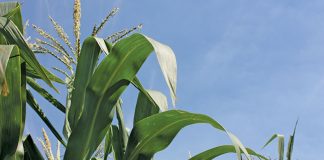
Photo: FW Archive
How do wind farms work?
A wind farm consists of a collection of wind turbines that generate electricity when wind rotates their blades.
The longer the turbine blades, the more energy can be generated. The wind farm also consists of associated infrastructure such as access roads, an onsite substation, an overhead power line to connect the facility to the national grid, and construction-related infrastructure.
READ West Coast abalone farm doubles in size, thanks to demand
The turbines are connected to one another via underground cabling or overhead lower-voltage power lines.
The electricity produced is ‘collected’ at a central substation from where it is fed into the national electricity grid owned by Eskom. Eskom then distributes the electricity and sells it to end-users. Wind farm projects generally refer to large-scale wind farming activities spread over very large areas, typically encompassing many properties.
Does wind farming hold significant potential in South Africa?
The country has significant wind resources and sufficient open land to produce wind power.
A study by the Council for Scientific and Industrial Research found that approximately 80% of South Africa’s land mass has enough wind for economically viable wind farms with an average capacity factor above 30%.
READ Western Cape boasts Africa’s first floating solar system
This figure refers to how Energyoften the facility will generate electricity at the maximum designed capacity; no wind farm will be able to have all of its turbines turning at 100% all the time. South Africa’s average capacity factor is significant compared with that of Europe’s wind fleet, which is 24%. This implies vast development opportunities for wind in South Africa.
What are the benefits of wind energy?
First, wind farms produce clean energy, and have a vital role to play in the global push to avoid impending climate disaster. For every MWh produced with wind energy instead of coal, we avoid 1t of carbon-dioxide emissions.
Second, wind power doesn’t require water to produce energy.
Third, it can create employment in areas with little other industry, such as the Karoo.
Lastly, it has the potential to provide income for farmers.
Are there any disadvantages?
In the past, there were instances where poorly planned projects threatened birds and bats.
New projects are subject to various mitigation measures to reduce such negative impacts and are closely monitored by specialists.
In terms of direct job creation, the construction of a project creates a significant number of immediate positions, but these drop sharply when the construction phase is over. However, new studies indicate that this disadvantage will be countered as renewable energy facilities become more mainstream.
How much space will a wind farm occupy, and must farmers evacuate their land when involved in a wind project?
Taking into consideration all the components of a wind farm, including the roads, turbine foundations, crane pads, construction camp and substation, one can expect a 140MW wind farm to cover an area of about 130ha.
READ Know the facts before switching irrigation systems
This is currently the largest wind farm that one can build in South Africa to secure a power purchase agreement under the Renewable Energy Independent Power Producer Procurement Programme (REIPPPP). This area is usually spread across several farms.
An individual farmer may find that the wind farm utilises as little as one tenth of that figure on his/her own property.
No evacuation is necessary. Wind farms and the agreements in terms of the rental of land for their operation are structured so that farmers can continue with their farming activities for the lifetime of the project, with anticipated disruption limited to the time of construction and decommissioning.
How do farmers get involved, and what role do they play in the development of the wind farm?
Normally, a wind farm developer identifies an area that offers potential as a wind resource and then approaches the landowners there with a proposal for the potential development.
The farmer, who is involved as the landowner, can continue with farming operations while providing, through a long-term lease arrangement with the wind farm, the security of tenure needed by a wind farm project to participate in the REIPPPP. Farmers don’t have to wait to be approached, however; they can contact a wind farm developer directly.
How much will it cost a farmer to get involved?
There are normally no costs to the farmer. The wind farm project company will endeavour to carry all costs pertaining to all studies, permits, rights and legal work that need to be done for the project. If any expenses are incurred by the farmer, reimbursement would normally be agreed upon in the contract between the farmer and the company beforehand.
What is the anticipated life of a wind farm, and what happens afterwards?
The sale of electricity generated by a grid-connected wind farm is currently governed by a Power Purchase Agreement (PPA) between the wind farm and Eskom. In the PPA, Eskom commits, under sovereign guarantee, to purchase generated electricity at a set tariff from the wind farm for a period of 20 years.
The South African REIPPPP kicked off in 2011, so we’ve not yet seen a full-term PPA run its course. The idea, as provided for in contracts, is for a wind farm to be decommissioned at the end of the PPA, removed from the farm, and the affected land rehabilitated.
What type of approvals are needed to begin construction of a wind project?
A typical development process will commence with the securing of land rights, followed by a 12-month wind measurement campaign to confirm the onsite wind resources.
Various other processes can then get under way; these include a 12-month bird and bat monitoring period, an environmental impact assessment, the design of the wind farm, consideration of existing mining rights, investigation of grid capacity, an assessment of the impact on civil aviation, and the rezoning of land.
It can easily take between three and five years to secure all required approvals. Construction can begin from the date that financial closure is reached, and typically lasts about two years for a 140MW wind farm.
What are the main stumbling blocks to the roll-out fo wind farms in South Africa?
The biggest obstacle is the recent delay in the publication of the new Integrated Resource Plan (IRP). The IRP governs the allocation to each energy source in the country’s energy mix and dictates the path for energy development until 2030.
In order for renewables to take their rightful place in this energy mix, there has to be a more consistent roll-out of renewable development energy over time.
Other barriers include policy uncertainty, strong competition between wind farm developers to secure PPAs, opposition from the coal industry, the high level of risk capital required, and the approvals needed.
Email Jacobus Treurnich at [email protected].











